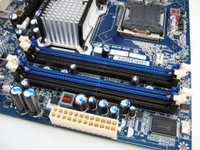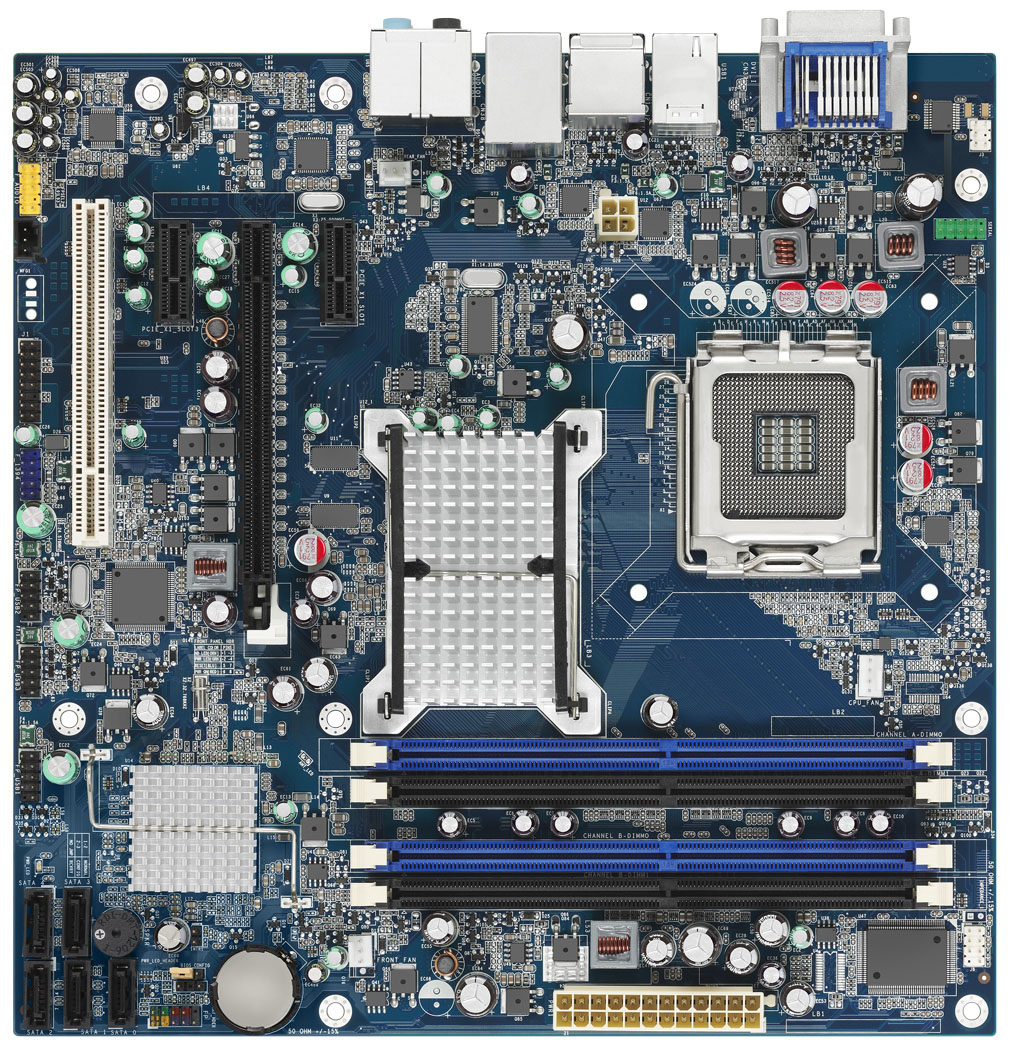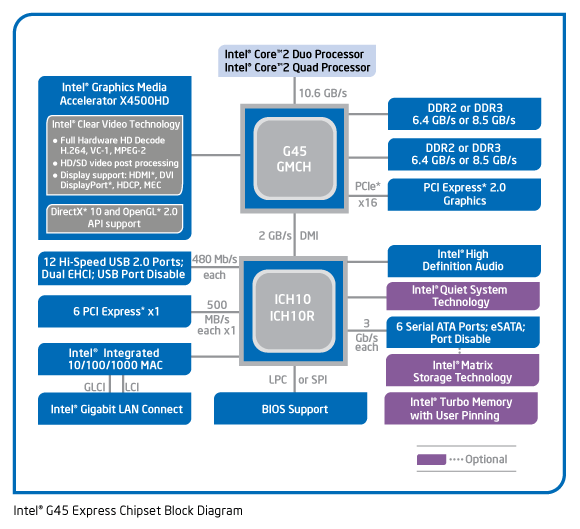Who Says You Need Four Cores?
Intel’s G45: Spend A Little More, Get A Little More
Who would have ever thought that, in a comparison between an AMD and Intel integrated graphics chipset, Intel would have the higher-end offering ? And yet, there it is, the new G45 memory controller hub complemented by the ICH10 I/O controller. In stark contrast to the 740G, G45 is thoroughly modern right down to its PCI Express 2.0 connectivity. The price you pay for the extra functionality is material : Intel’s DG45ID costs about twice what you’d pay for the 740G board we just covered.
The G45 Memory Controller Hub
Of course, Intel’s current platform architecture is significantly different from AMD’s, so it relies on a front side bus connection to an installed Core 2 Duo or Core 2 Quad processor. Support for speeds up to 1,333 MHz means G45 can take any processor in the company’s desktop line except the fastest Extreme Edition parts that operate on 1,600 MHz buses.
The northbridge works with two channels of DDR2 or DDR3 memory running at up to 800 MHz or 1066 MHz, respectively. Again, the integrated graphics engine relies on system bandwidth for its best possible performance. We’re not building this box for gaming, but if you did want to engage in some very entry-level entertainment, faster modules should help improve frame rates.
Built into G45 is Intel’s new GMA X4500 HD—an improved graphics core that purportedly represents a big step up from the mediocre GMA X3500 found in its predecessor, G35. The G45 MCH is manufactured at 65nm versus the 90nm used to etch the last generation of chipsets. As a result, there is more room for graphics hardware. GMA X4500 HD features 10 unified shader processors, up from the X3500’s eight. Like the X3500 core, G45 supports DirectX 10 and OpenGL 2.0. Just don’t expect super performance. While Intel claims a significant step-up from what came before, the bar was set very low with G35—a chipset that wasn’t DirectX 10-enabled through drivers until a few months ago.
More promising than the chipset’s 3D capabilities (especially in the context of a workstation) are its video processing capabilities. The HD in GMA X4500 HD means full 1080p high-definition playback, according to Intel. The built-in Clear Video Technology supports hardware decode for H.264, VC-1, and MPEG-2, in addition to HD post-processing. Output connectivity includes HDMI, DVI, and DisplayPort, though the DG45ID sample we’re testing only comes with HDMI and DVI. Amazingly enough, Intel delivers dual independent display controllers through G45, proving that at least one chipset vendor can drive two digital displays with an integrated core.
Update : Having just read Aaron Brezenski’s blog post on Intel’s Software Network, I thought I’d bring up a couple of important points if you’re interested in tying G45 into a home theater instead of a business desktop. First, Blu-ray performance. Using the right software player with Clear Video optimizations will cut CPU utilization to the levels we report in the benchmark section. We did work with Intel to ensure we were using the right BIOS configuration, but it’s worth noting that Intel’s recommended settings wouldn’t stick on our eval. platform. Intel says that an upcoming BIOS release will clarify the setting in question to make it more explanatory.
Get Tom's Hardware's best news and in-depth reviews, straight to your inbox.
With that said, a quick browse through Aaron’s post reveals that 24 Hz playback is problematic (relevant if you own a TV with that refresh), as is trying to send an HDMI signal through a receiver (sending signals directly to a TV purportedly works). He also says that image-quality issues affecting the HD HQV benchmark will have to be worked out through driver updates (not exactly reassuring given the software team’s track record with G35 and DirectX 10).
Of course, if you’d rather not hassle with the integrated core at all, a single x16 PCI Express 2.0 link will take a discrete board. It cannot be divided to support a pair of x8 slots, however.
The ICH10R I/O Controller Hub
Attached to the G45 through Intel’s 2 GB/s DMI link is its ICH10R controller. This is another of those chipset components we’ve covered in the past, so I’ll keep it brief here.
The ICH10R offers six lanes of PCI Express connectivity, an integrated Gigabit MAC, 12 USB 2.0 ports, support for HD Audio, and six SATA 3 Gb/s ports with support for RAID 0, 1, 10, and 5. Turbo Memory with user pinning is also possible through the ICH part, but we’d just as soon build a machine armed with more DDR2 than rely on Turbo Memory technology.
The Platform
This one is going to hurt the wallet a bit more, but it should be expected to serve up better graphics performance, if only because of the motherboard we’re using.
| Motherboard | Intel DG45ID |
| Processor | Intel Core 2 Duo E7200 @ 2.53 GHz |
| Memory | 4 GB (2 x 2 GB) Corsair Dominator DDR2-1066 5-5-5 |
| Graphics | GMA X4500 HD Integrated |
| Hard Drive | Seagate Barracuda 7200.11 500 GB SATA 3 Gb/s |


Add up the vital pieces here and you’re looking at a $470 build. Factor in the same optical drive and InWin chassis and this becomes a $560 dollar build. All else being equal, the Intel motherboard and processor are going to cost an extra $110 or so—the questions is, are they worth the extra investment ? Whereas AMD has the advantage in pricing, Intel should be expected to turn in better performance. And while AMD is able to offer the 2.5 GHz Athlon X2 4850e at 45 W, Intel’s Core 2 Duo E7200 is a 65 W part.
Of course, specs alone aren’t enough to tell us whether a quad-core configuration is really necessary for solid desktop performance.
Current page: Intel’s G45: Spend A Little More, Get A Little More
Prev Page AMD’s 740G: From Obscurity To Your Desktop Next Page Test Setup-
Well. It seem like virtualisation was left out as consider multi-core is critical for running virtualise application.Reply
-
apache_lives waste of time to read, its been known for years that you dont compare clock speeds (in this case, 2.53ghz) - you compare price points! Wheres an Intel Quad? or a lower end Intel like a E4600 etc? and after all that BS, why the cheap AMD board thats "$10 - $15 less" against that expensive ass intel board? pfffttttReply -
The_Trutherizer I completely don't get the point of the phenom 9850 in this review. Isn't this supposed to be a comparison of budget, workstation systems with dual core CPUs? Why put it in there? If you put a current Intel quad core in for consideration then it's power consumption would be high as well.Reply
What exactly are you trying to prove here? In any case. Any idiot knows that currently Intel's Dual core is the ideal processor. Currently of course.
And what the hell were you thinking with the motherboard? A 740G? You even state in your conclusion that the 780G is a more fair comparison to the G45? Of course it is! Why did you even review the 740G then?
I mean what a conflicting hodge podge of an article! -
genored If you haven't bought a new computer in 6 years don't do a review about your epic fail of picking computer parts. I mean your just embarrassing....Reply -
rtfm If you give a million monkeys a typwriter, one of them will write a T.H article... Seriously, most of the readers of this site are well informed, this king of waffle is no goodReply -
curryj02 so quad isn't worth it now... what about in six years. just as Hyper Threading has kept his P4 going so long, going quad will have the same effect. Quad doesn't scale now, but in six years? dual core will seem like single core is now - quad core = new dual core. Just my two centsReply -
addiktion I currently run a Q6600 (3GZ OC) and it has done wonders for me. Take it I do a lot of Adobe Photoshop, gaming, coding, and generally have about 20-30+ windows open at one time which I would consider my "business" & "entertainment" use.Reply
If you add virtualization into the mix the quad core definitely has saved me. I don't experience any hiccups and now that I've migrated to 64 bit I've noticed a subtle gain in overall computing too.
I think the highest I've hit on all my cores with extensive testing is 60-70%. This was running a few browser windows + 4 scanning programs at the same time and I did get some slow down due to my hard drive read/write speeds maxing out but nothing from the CPU. Which to me leaves plenty of room for what I actually do.
Eventually when more software actually catches up to using 4 cores it'll be better utilized I suppose but for the most part I'm happy with it and I think you'll be happy with a dual or quad core. -
fepple Running HL2:EP2 as a benchmark is pretty silly when its only single threadedReply
"shocking news! new super car max speed only 30mph in residential areas" -
jitpublisher Nothing surprising, interesting, or useful about this. Am I missing something, was the article incomplete and posted early? Just don't get it.Reply



